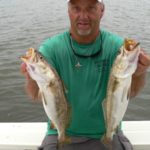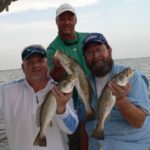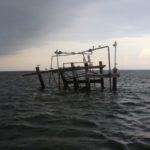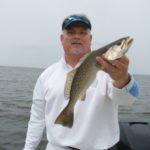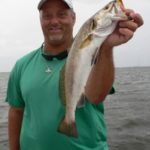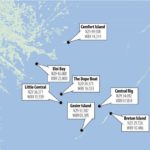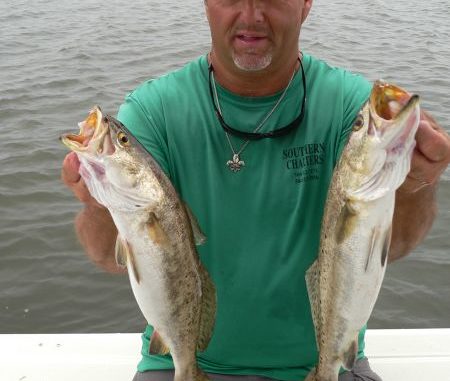
Don’t let the oppressive heat keep you off the water. Instead, head to these proven Breton Sound hotspots for plenty of trout action.
Welcome to the dog days of summer. The next few weeks are typically considered the hottest days of the year in the northern hemisphere, a time when men and beasts stew in sweltering heat and humidity.
Many think “dog days” is associated with the way the oppressive heat turns dogs into panting, lazy, foaming-at-the-mouth pictures of misery trapped in irremovable fur coats.
But ancient Romans actually coined the term because Sirius, the “Dog Star” and the brightest member of the constellation Canis Major (Large Dog), rises at almost the identical time as the sun between July 24 and August 24 — and the ancients believed Sirius added its light and heat to days that were already too hot to bear.
According to early beliefs, the dog days were evil days, when temperatures soured the wine and boiled the seas, and the temperaments of men and beasts soured and boiled along with them.
It is interesting to know that police departments across the United States notice an uptick in crimes of violence this time of year. So maybe the ancients were on to something.
In any case, no one can deny the heat and humidity associated with this time of year — but August is far from evil (unless it spawns hurricanes) when it comes to fishing.
Actually, it’s a good time to point your bow toward Breton Sound and burn up some fuel.
That was precisely my intent when I invited some good friends to join me for a trip into the deep Sound.
John Herman and Perry Matulich were eager to go, undeterred by a forecast of 93-degree temperatures that would feel like 101 with the humidity factored in.
The bonus was a last-minute walk-on when Capt. Casey Kieff had a last minute cancellation and offered to pilot us to the fish.
I already had Herman and Matulich primed for a trip to Gosier Island, and the nearby rigs and structures. I knew from personal experience that Breton Sound is one of the very best places to fish this month because the deeper water attracts fish seeking relief from the heat.
We gravitate to air-conditioned cars, houses and buildings this time of year to escape the oppressive heat, and fish find similar relief in deeper depths.
I also know that Breton Sound is vast, and its islands and numerous platforms and structures of all sizes can hold anything from big specks to redfish, sheepshead, drum, sharks, jacks, Spanish mackerel, ladyfish — you name it.
The point: You’ll definitely catch something, and what you catch will probably be big.
Kieff took the helm of my Triton Bay Boat, and we settled in as he accelerated the 250-horse outboard to 4400 RPMs for the early morning ride into the Sound.
We could see dark skies and lightening far in front of us, and we hoped the weather would move on or dissipate before we got close to it.
Unfortunately, it seemed to park itself between us and our destination, forcing us to stop shorter than planned.
Kieff pulled up to a small wellhead, and I grabbed it and held us close to it with the rig hook.
“Let’s give this a few minutes to see where that weather heads,” Kieff said.
Our plan was to resume our trek once the system passed. Meanwhile, we fished.
We all tossed bottom rigs in the deeper water, some loaded with live shrimp on Carolina rigs, others just bouncing plastic on 3/8- or ½-ounce jigheads.
Kieff said the fish he caught in the previous days showed no reluctance to hitting soft plastics, and virtually anything in either chartreuse or white provoked good bites.
I was tossing a Slammin’ Sammy Deadly Dudley on a 3/8-ounce jig, using a cast-and-retrieve bounce-along-the-bottom retrieval when I was rudely interrupted by a sudden drop in temperature from a chilly down-burst accompanied by a thundering crack of lightening.
Time to go!
Initially, we turned toward the MRGO rocks, where we knew we could find some fish and wait out the storm, but the rocks were also enveloped in a dark rain cloud and lightening flashed from that direction. The thunderstorms also churned up the seas, and we found ourselves scanning the horizon for a place to hide.
We decided to duck behind a platform in Bay Eloi and fish until we got a break in the weather.
Kieff said this entire area offers a lot of options for trout anglers.
“There are many, many places to fish out here this month,” he said. “From the numerous structures big and small in Bay Eloi to the MRGO rocks, you can bounce around in here all day and catch fish.
“I’ll go from one rig to another, and I don’t pass up the small wellheads because they often produce more consistently than the bigger structures. Maybe because fewer people fish the smaller ones and they don’t get as much pressure.”
He said he always has some shrimp aboard.
“ Live shrimp is always the best bet, because while they will often hit plastics, sometimes they won’t touch it — and on those finicky days if you don’t have live shrimp you’re going to be out of luck,” Kieff said. “Try fishing under a cork, free-lined and on bottom.
“If the water is over 6 feet deep, I usually just cast and retrieve with plastics on a 3/8-ounce jig, or I bottom fish or free-line.”
Kieff said you should have a rig hook handy to hook on to the structures, and then fish out and away from the platforms, or you can anchor and fish both toward and away from them. Or you can troll around them in a wide circle looking for fish.
Once you get into some action, anchor so you can fish the hotspot.
Just to the north is another great target for trout anglers Comfort Island.
“Comfort Island has produced pretty good this year,” Kieff said. “It got messed up for awhile when the high river flooded the area with muddy river water, but the trout definitely like to hang out over the big reef on the southwest side of the island.”
Finding that reef isn’t very difficult.
“Watch your depth finder, and when you see the bottom rise up from 6 feet to 3 to 4 feet you know you’re over the reef,” Kieff said. “Stick your Power-Pole and fish live shrimp or Vudu shrimp, DOAs, TKOs or whatever your favorite plastic is under a cork.”
His approach is to move around until he finds some fish.
“Give the spot 15 to 20 minutes, and if nothing hits move a hundred feet or so,” he said. “The reef is huge so it can accommodate a lot of boats.
“But if there are no other boats around it may not be producing — or if the boats that are around aren’t pulling fish over the gunnel, you might as well move on.”
Other options lie in the open waters of the Sound.
“Little Central is the area roughly between the large Block 18 rig just off the northeast side of the MRGO, all the way to the Compressor Rig on the opposite side,” Kieff said. “There are three bigger platforms and a bunch of smaller satellite structures in between them.
“It’s a pretty big area, and it produces some nice trout and big reds, even in August.”
Kieff said the water in this area is deeper, so bottom rigs like drop-shots or sliding-sinker rigs are called for — but a sliding cork is also a good choice because it’ll keep you off the debris laden bottom.
The Central Rig itself is a huge platform, but it is surrounded by several nearby big satellite structures that many anglers find even more productive than Central itself.
Keiff said to hook onto any of them that are unoccupied by another boat (which can be a challenge on weekends, especially on those days when the conditions are very favorable), and fish the bottom.
“Many of the satellites are tall but not very wide, and they can accommodate only one boat in the prime fishing spot,” he explained. “It’s strictly first come-first served, so an early start is especially important this month.”
He said there are really two reasons to leave the launch early.
“One, the trout bite in the dog days of summer is short and early,” Kieff said. “It can be over by 7, 8 or 9 a.m. Leave late and you miss the prime time.
“Two, if you leave late on a good day — especially on weekends — those structures are all going to have boats parked around them by the time you get there. You’ll be running around looking for a parking spot. The only exceptions will be if you go out on a weekday or a marginal day when others don’t venture out. Or, when the fish just aren’t cooperating.”
And don’t hit this area without plenty of tackle.
“… (Y)ou should come prepared to retie your terminal tackle out here quite a bit because there are a lot of big, toothy critters in these waters, especially in August,” Kieff said. “The water is 15 to 20 feet deep, so you’ll be fishing the bottom, and big trout hang out here — along with big reds, sheepshead, sharks, Spanish mackerel, jacks, bluefish, ladyfish, you name it.
“We even catch pompano out here. You never know what’ll eat your bait in this area.”
When the weather cooperates, you can also make the long run to the bottom end of the Chandeleur Islands.
Gosier and Breton islands are my favorite places to fish in the summer. Whether you wade-fish or fish from inside the boat, there’s just something special about fishing along the Gulf Coast’s first line of defense.
Breton Island still has actual sand to walk along and wade in (no, you won’t sink in mud), while Gosier is only a shoal — but these islands definitely hold fish.
“You can definitely catch anything along the islands and at the nearby rigs,” Keiff said. “We catch it all: trout, reds, drum, flounder, sheepshead, banana fish, Spanish mackerel, cobia, jacks, sharks stingrays, catfish. It’s a hodgepodge out there.
“I like to fish topwater baits when the conditions allow it, or I’ll just cast and retrieve plastics between the sandbars, or use live shrimp on a Carolina rig or even under a cork in water 3 to 4 feet deep.”
The Dope Boat is a Breton Sound hotspot that has been a fish magnet for some 40 years. Almost nothing is visible above the surface anymore, so use caution navigating around it.
But don’t pass it up.
Years ago the small dope-smuggling ship ran aground and was scuttled by the crew. The wreckage settled in about 14 to 15 feet of water and became an immediate fish magnet.
It’s just off the MRGO about 4 miles past the end of the long rocks, so it gets plenty of good water. And for the first 30 years or so produced incredible numbers of nice-sized trout.
But years of marinating in salt water have taken their toll on the old hulk, and almost all of it is now either buried under the mud or rusted away, so the small amount of structure that’s left just doesn’t hold as many fish as it used to.
“Mostly, we fish around it under corks because you’ll hang up a bottom rig on the underwater structure, but live shrimp or plastics can still be devoured by some big trout out there this month,” Keiff said.
Of course, the MRGO rocks should be on any angler’s list.
The 8-mile-long “Long Rocks” have produced trout, reds, sheepshead, drum, jacks and just about everything else that swims in the shallow Gulf waters.
Anchor or troll along the jetty, and fish under a cork with live shrimp or plastics. I like to toss topwater baits when the conditions allow it, and you can always expect the unexpected.
Like the 24-pound red that inhaled my bait and fought valiantly before surrendering. We netted the beast, took a few photos and released it to fight another day.
The weather never did cooperate that day, but we bounced around enough to box more than 50 trout before the thunderstorms chased us in.
If you venture out there this month, keep an eye peeled for thunderheads and give them wide berth.
Live to fish another day.
Editor’s note: Capt. Casey Kieff can be reached at 504-512-7171.
